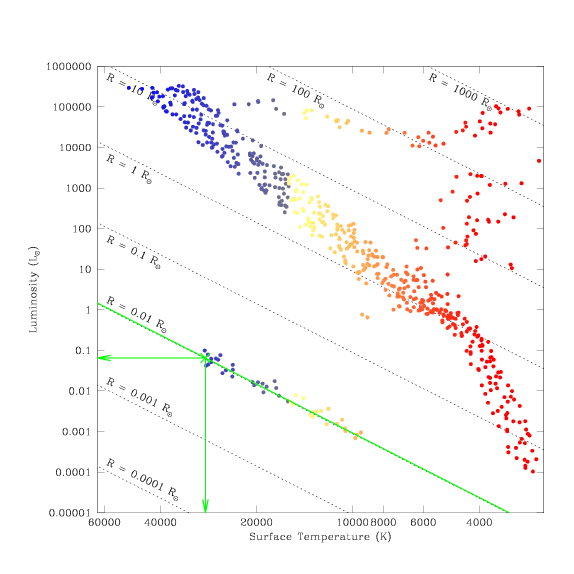What kind of stars are found here?
A star in this region of the Hertzsprung-Russell diagram has a temperature of
roughly 29,000 Kelvin (29,000 K), a luminosity 20 times less than that of the
Sun (0.05 × L ), and a radius one hundred times smaller than the Sun
(R = 0.01 × R
), and a radius one hundred times smaller than the Sun
(R = 0.01 × R ).
This star lies along the narrow band where white dwarf stars are found. The
high temperature indicates that this star is the end-product of a recent nova
of a low-mass star (an older star would have had more time to cool, and to
move down the white dwarf sequence to lower luminosities and cooler
temperatures).
).
This star lies along the narrow band where white dwarf stars are found. The
high temperature indicates that this star is the end-product of a recent nova
of a low-mass star (an older star would have had more time to cool, and to
move down the white dwarf sequence to lower luminosities and cooler
temperatures).
Try to read the values of L, T, and R for yourself from the diagram. Do
you estimate values for the luminosity, temperature, and size of the star
similar to those listed above?

How can we find the exact luminosity L of a white dwarf in this
region of the Hertzsprung-Russell diagram, if we know its temperature T and
its radius R?
We can use the Stephan-Boltzmann Law to relate the temperature (T), size (R),
and luminosity (L) of a star to each other. Measuring L, R, and T in solar
units, we say that:

Let us say that the temperature of the star is exactly 28,900 K. We know that
the temperature of the Sun is 5,800 K, so we can convert the temperature of
the star into solar units. This is just a way of asking How hot is the
star relative to the Sun? (If the star is six as hot as the Sun, for
example, T = 6 × T . If the star is six times cooler as the Sun, T =
0.166 × T
. If the star is six times cooler as the Sun, T =
0.166 × T .)
.)

This star is five times hotter than the Sun.
Now assume that the radius of the star is exactly 0.0103 × R . (We
don't need to convert this radius to solar units, as we are already using
them.)
The final step is to calculate the luminosity L, from T and R.
. (We
don't need to convert this radius to solar units, as we are already using
them.)
The final step is to calculate the luminosity L, from T and R.

We estimated a value of L = 0.05 L from the diagram, for
stars found in this area – so we did a reasonable job!
from the diagram, for
stars found in this area – so we did a reasonable job!
 ), and a radius one hundred times smaller than the Sun
(R = 0.01 × R
), and a radius one hundred times smaller than the Sun
(R = 0.01 × R ).
This star lies along the narrow band where white dwarf stars are found. The
high temperature indicates that this star is the end-product of a recent nova
of a low-mass star (an older star would have had more time to cool, and to
move down the white dwarf sequence to lower luminosities and cooler
temperatures).
).
This star lies along the narrow band where white dwarf stars are found. The
high temperature indicates that this star is the end-product of a recent nova
of a low-mass star (an older star would have had more time to cool, and to
move down the white dwarf sequence to lower luminosities and cooler
temperatures).



